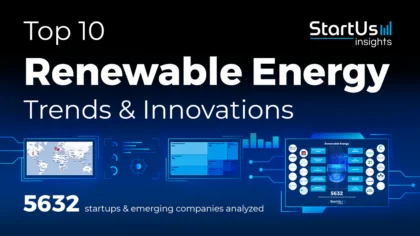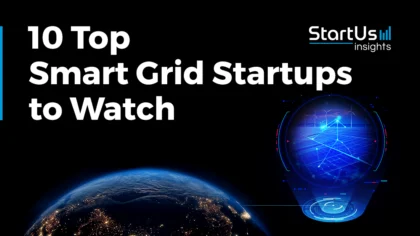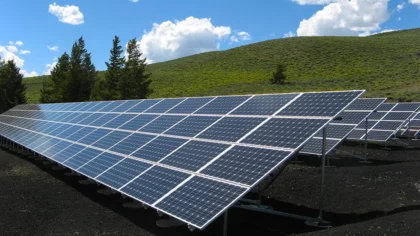Artificial intelligence (AI) strengthens grid stability by predicting energy patterns while blockchain offers transparency in energy transactions. Augmented and virtual reality (AR/VR) solutions reduce operational costs through efficient maintenance and immersive training. Additionally, cleantech is optimizing energy capture and distribution. Continue reading to discover how these technologies are defining the future of renewable energy and accelerating the energy transition.
Why should you read this report?
- Gain in-depth insights into the top 10 technologies impacting renewable energy.
- Learn about three practical use cases for each technology.
- Meet 10 innovative startups advancing these technologies.

Key Takeaways
- Artificial Intelligence
- Use Cases:
- Smart Grid Management
- Energy Consumption Analysis
- Predictive Maintenance
- Startup to Watch: REint
- Use Cases:
- Internet of Things (IoT)
- Use Cases:
- Asset Maintenance
- Predictive Maintenance
- Smart Transformers
- Startup to Watch: EnerMAN
- Use Cases:
- Advanced Robotics
- Use Cases:
- Inspection of Energy Infrastructure
- Automated Repair
- Pipeline Monitoring
- Startup to Watch: HekaBot
- Use Cases:
- Additive Manufacturing
- Use Cases:
- Component Manufacturing
- Rapid Prototyping
- Custom Enclosures
- Startup to Watch: Leap Photovoltaic
- Use Cases:
- Augmented Reality & Virtual Reality
- Use Cases:
- Training and Simulations
- Remotely Guided Maintenance
- Infrastructure Design and Planning
- Startup to Watch: 3spin Learning
- Use Cases:
- Blockchain
- Use Cases:
- Energy Trading
- Grid Security
- Renewable Energy Certificate
- Startup to Watch: IPE Assets
- Use Cases:
- Big Data & Analytics
- Use Cases:
- Load Forecasting
- Grid Optimization
- Renewable Integration
- Startup to Watch: Telos Energy
- Use Cases:
- CleanTech
- Use Cases:
- Energy Storage Solutions
- Smart Grids
- Energy Efficiency Improvements
- Startup to Watch: W2E Cleantech
- Use Cases:
- Cloud Computing
- Use Cases:
- Decentralized Energy Resources (DER) Management
- Grid Analytics
- Remote Asset Monitoring
- Startup to Watch: Renovus
- Use Cases:
- Connectivity Technologies
- Use Cases:
- Smart Meters
- Demand Response
- Grid Automation
- Startup to Watch: i-EM SAT
- Use Cases:
Renewable Energy Industry FAQs
What are the types of renewable energy?
Renewable energy includes solar, wind, hydropower, geothermal, and biomass. Solar energy uses sunlight through photovoltaic (PV) cells, while wind energy captures the kinetic energy from wind turbines. Hydropower generates electricity by using flowing water, and geothermal energy extracts heat from the earth’s core. Biomass, on the other hand, converts organic materials like plant and animal waste into usable energy.
What are the challenges of renewable energy?
The key challenges in renewable energy include variability, high initial investment, and infrastructure limitations. Solar and wind energy depend on weather conditions and, hence, intermittent. The upfront costs of deploying large-scale renewable systems remain substantial, and existing energy grids require upgrades to accommodate renewable energy integration. Additionally, energy storage remains a technological hurdle that affects reliability.
What are the benefits of using renewable energy technologies?
Renewable energy technologies reduce greenhouse gas emissions, contribute to energy independence, and promote long-term cost savings. By shifting to renewable sources, industries decrease their reliance on fossil fuels to lower their carbon footprint. Renewable technologies also diversify energy sources that minimize geopolitical risks related to fuel supply chains. Over time, the operational costs of renewable energy remain lower due to minimal fuel expenses and reduced maintenance.
How We Identify Emerging Technologies & Startups
The data in this report originates from StartUs Insights’ Discovery Platform, covering 4.7 million global startups, scaleups, and technology companies, alongside 20,000 emerging technology trends. Our platform makes startup and technology scouting, trend intelligence, and patent searches more efficient by providing deep insights into the technological ecosystem. Utilizing the trend intelligence feature, we analyze industry-specific technologies for this report, detect patterns and trends, and identify use cases along with the startups advancing these areas. Further details and capabilities are accessible via the website.
10 Emerging Technologies Impacting the Future of Renewable Energy
1. Artificial Intelligence

In the renewable energy sector, AI tackles the intermittency of sources that cause supply fluctuations. AI stabilizes the grid by predicting generation patterns and balancing supply with demand. AI also reduces high maintenance costs by proactively identifying potential equipment failures in wind turbines and solar panels. This minimizes downtime and repair costs. For efficient storage and distribution, AI improves energy storage and management.
3 Practical Use Cases of Artificial Intelligence in Renewable Energy
- Smart Grid Management: AI continuously monitors the electricity grids to balance supply and demand by integrating renewable energy sources.
- Energy Consumption Analysis: Provides energy use and evaluates consumption trends to reduce expenses and increase sustainability by finding inefficiencies and minimizing energy waste.
- Predictive Maintenance: AI predicts equipment failures and schedules timely maintenance to reduce downtime and extend the lifespan of renewable energy assets.
Startup to Watch: REint
REint is a US-based company that develops an AI-powered platform to integrate renewable energy sources and improve grid resilience. It offers real-time updates on energy loads and weather every for utilities to effectively manage power procurement, energy traders to optimize market positions, and independent power producers to minimize imbalances. This also improves the functionality of smart home management systems and battery storage. The company’s AI models maintain consistent annual performance and achieve higher accuracy across metrics such as MAE and MAPE.
2. Internet of Things

Smart grids use IoT sensors to monitor energy distribution in real time to balance supply and demand. IoT-enabled wind turbines provide performance data for proactive maintenance that reduces downtime. IoT-based energy storage systems further optimize energy storage by monitoring battery performance and adjusting release based on demand. These solutions address equipment failure, resource management inefficiencies, and data integration challenges.
3 Practical Use Cases of the Internet of Things in Renewable Energy
- Asset Maintenance: IoT sensors monitor the health and functionality of renewable energy assets. This strategy prolongs the life of assets and avoids unplanned failures.
- Predictive Maintenance: The data from the Internet of Things enables predictive maintenance that anticipates equipment failures in advance. This approach lowers maintenance costs and downtime by fixing issues before they occur.
- Smart Transformers: To monitor and control electrical systems, smart transformers incorporate Internet of Things technologies. These transformers provide real-time data on electrical demands and possible problems, which improves grid efficiency and stability.
Startup to Watch: EnerMAN
EnerMAN is an Indian startup that delivers IoT-based AI/ML-driven SCADA and digital solutions to improve the performance of solar PV plants and rooftops. Its product, ETi-SOL, provides cloud-based monitoring and control of PV plants for remote oversight and performance enhancement. The company’s other solutions are ETi-PPC for active and reactive power control and ETi-ZES for zero energy export to the grid. EnerMAN’s solutions feature real-time power control, customizable dashboards, and automatic reporting through web and mobile apps.
3. Advanced Robotics

Robotics impacts the renewable energy industry by addressing efficiency, safety, and cost issues. Robotic arms handle precise maintenance, such as repairing wind turbine blades and solar panels, in hard-to-reach areas, and extend equipment lifespan. Underwater robots inspect and maintain offshore turbines and infrastructure. Pipeline robots detect leaks and structural issues that prevent environmental hazards. Further, these solutions boost operational efficiency, reduce safety risks, and lower maintenance costs.
3 Practical Use Cases of Advanced Robotics in Renewable Energy
- Energy Infrastructure Inspection: Robotics perform detailed inspections of energy infrastructure to detect wear and damage. This improves safety and reduces the need for human labor in hazardous environments.
- Automated Repair: Robotics carry out repairs on energy infrastructure, like turbine blades, with high precision. This process minimizes downtime and improves equipment reliability.
- Pipeline Monitoring: Robots conduct continuous monitoring of pipelines for leaks and integrity issues. This prevents environmental hazards and ensures the smooth operation of energy transportation systems.
Startup to Watch: HekaBot
Indian startup HekaBot delivers an AI-based waterless robotic cleaning system for solar modules. It utilizes AI and cloud-based networking to perform efficient, waterless cleaning to increase solar power production while minimizing human intervention. The robot features a self-locking system that prevents sliding in windy conditions, while its auto-detect capability identifies module misalignment. Equipped with predictive maintenance and smart weather detection, the robot integrates with SCADA via cloud-based networking for real-time monitoring and data transfer. HekaBot’s system also reduces water usage and provides an automated alternative to traditional cleaning methods for maintaining solar panel efficiency.
4. Additive Manufacturing

The renewable energy business faces long supply chain lead times and high production costs, which 3D printing technology solves. To decrease dependency on foreign suppliers and speed up production, the technology allows local manufacturing of components. 3D printing improves solar energy by producing personalized photovoltaic cells while wind turbine companies leverage additive manufacturing to improve blade performance and maximize material utilization. Modular, 3D-printed components also speed up the construction of renewable energy plants. These solutions create cost savings and increase sustainability.
3 Practical Use Cases of Additive Manufacturing in Renewable Energy
- Component Manufacturing: With less material waste, 3D printing simplifies the fabrication of complex elements like solar panel sections and turbine blades. This aids in the more effective production of renewable energy while reducing expenses.
- Rapid Prototyping: Additive manufacturing offers the quick creation and testing of new designs for energy storage systems and wind turbines. This leads to a shorter time to market.
- Custom Enclosures: 3D printing creates tailored enclosures for sensitive renewable energy components, such as inverters or battery systems. These customized designs improve the protection and performance of critical energy infrastructure.
Startup to Watch: Leap Photovoltaics
Leap Photovoltaics is a US-based startup that creates crystalline silicon solar cells using additive manufacturing. Its method yields the same performance as conventional cells at a lower cost by substituting a mechanically resistant printed layer of monocrystalline silicon for typical silicon wafers. By utilizing safe, domestic supply chains, this method lowers the costs of solar manufacturing. The company also uses industry-standard testing to confirm the longevity and efficiency of its cells, matching the caliber of silicon wafer-based cells.
5. Augmented Reality & Virtual Reality

AR and VR address shortages of specialized labor, infrastructure management, and cost-effectiveness in the renewable energy sector. AR provides hands-free, real-time maintenance instructions that cut down on downtime and travel expenses. Workers are able to digitally perform activities to further improve abilities safely and simulate hazards using VR-based training. By superimposing virtual models on actual locations, AR also aids in infrastructure design by increasing accuracy and reducing errors. These technologies expedite the transition to sustainable energy while reducing costs, increasing efficiency, and addressing labor shortages.
3 Practical Use Cases of AR & VR in Renewable Energy
- Training and Simulations: Immersive virtual environments where technicians and engineers undergo hands-on training reduce training costs and minimize the risks associated with real-life practice in the renewable energy industry.
- Remotely Guided Maintenance: AR provides real-time guidance for technicians working on remote wind turbines or solar farms. This improves operational efficiency while reducing the need for on-site experts.
- Infrastructure Design and Planning: Engineers use VR to visualize and refine the layout of renewable energy plants before construction. It creates more accurate and cost-effective designs while minimizing risks.
Startup to Watch: 3Spin Learning
German startup 3spin Learning offers customized VR, AR, and AI-powered training solutions to improve work processes in the power sector. It provides interactive training environments where employees safely practice troubleshooting and hazard identification. Using 3D object templates and an extensive asset library, trainees also learn safety procedures in a controlled virtual space. This improves skills development and reduces maintenance costs with real-time data and visual instructions.
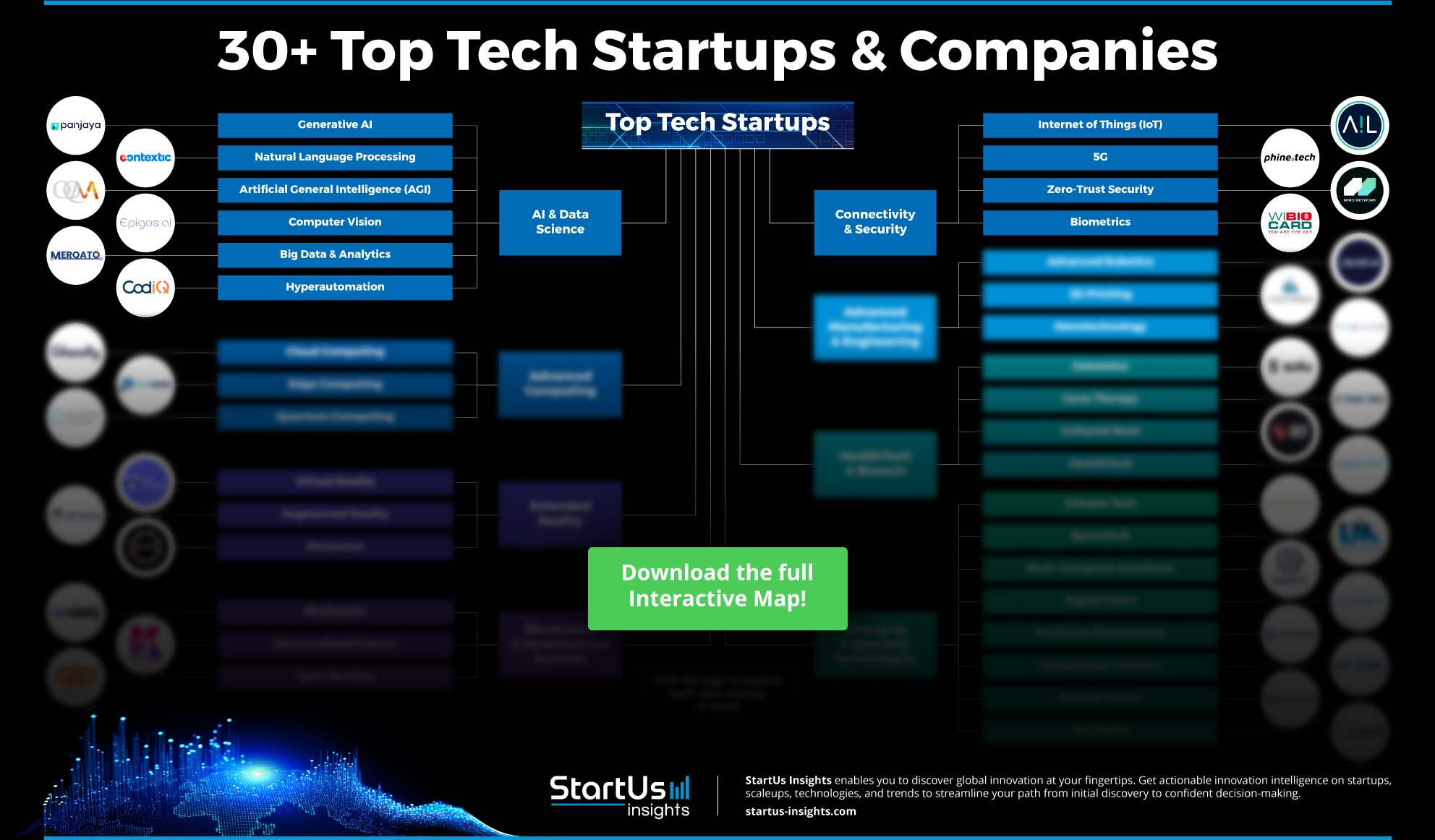
6. Blockchain

Blockchain tackles key concerns such as transparency in energy trading and grid security. Blockchain’s immutable ledger mitigates fraud and disputes by providing a clear record of transactions in energy trading platforms. The decentralized nature of blockchain fortifies grid security by reducing the risk of centralized attacks and ensuring data integrity. Additionally, smart contracts align the execution of energy transactions by automatically enforcing agreements that further reduce administrative overhead. These solutions manage energy transactions and incentivize renewable energy production.
3 Practical Use Cases of Blockchain in Renewable Energy
- Energy Trading: Blockchain offers secure, transparent energy trading by recording all transactions on an immutable ledger. This transparency reduces disputes and increases market efficiency.
- Grid Security: Blockchain strengthens grid security by decentralizing data storage and reducing vulnerability to centralized attacks. It provides data integrity and increases security measures.
- Renewable Energy Certificate: Blockchain simplifies the issuance and tracking of renewable energy certificates. It offers accurate certification and verification of renewable energy production.
Startup to Watch: IPE Assets
IPE Assets is a Brazilian startup that democratizes high-yield investing by offering tokenized asset management solutions focused on renewable energy. It backs NFT tokens with real assets such as photovoltaic plants to create new investment opportunities in the energy sector. By using blockchain, IPE Assets makes energy investment into a more transparent and cost-efficient model.
7. Big Data & Analytics

In the renewable energy sector, big data and analytics handle problems like resource intermittency, inefficiencies, and grid integration. Predictive maintenance systems reduce downtime and increase asset longevity by anticipating equipment breakdowns using sensor data and previous records. Weather forecasting algorithms analyze meteorological data to predict trends and improve the energy production of wind and solar farms. Demand response systems further forecast changes in demand by examining consumption trends to reduce grid stress and enhance distribution. These technologies also reduce operational hazards and improve production reliability.
3 Practical Use Cases of Big Data & Analytics in Renewable Energy
- Load Forecasting: Algorithms predict energy demand by analyzing consumption patterns and weather conditions. It allows renewable energy operators to manage supply, prevent shortages, and ensure grid stability.
- Grid Optimization: Improves the distribution of renewable energy by analyzing grid performance and identifying inefficiencies. It allows utilities to improve energy flow and reduce transmission losses.
- Renewable Integration: Data analytics solutions analyze how to blend renewable sources into the grid without destabilizing it. This provides a smooth transition from fossil fuels while maintaining a consistent energy supply.
Startup to Watch: Telos Energy
US-based company Telos Energy offers grid analytics solutions to integrate solar, wind, storage, and transmission resources. It uses in-depth grid models and simulations to evaluate how new markets, technology, and regulations affect electricity systems. This enables businesses to optimize their plans for renewable integration and transmission. Further, the company also boosts the development of energy storage plans for a more efficient and clean power system.
8. CleanTech

Energy storage solutions like Tesla’s Powerwall and LG Chem’s RESU capture excess renewable energy for later use. Smart grids improve the efficiency of energy distribution, allow real-time adjustments, and reduce energy waste. Additionally, energy management systems (EMS) improve energy consumption and increase grid stability. High-efficiency solar panels increase the amount of energy captured from sunlight and maximize the return on investment for solar installations.
3 Practical Use Cases of CleanTech in Renewable Energy
- Energy Storage Solutions: Capture excess energy for later use. This capability provides a consistent energy supply and ensures the reliability of renewable sources.
- Smart Grids: Optimize energy distribution and management to improve grid efficiency and reduce energy loss.
- Energy Efficiency Improvements: Increase energy efficiency through monitoring and management systems. They enable better resource utilization and lower energy consumption.
Startup to Watch: W2E Cleantech
W2E Cleantech is a Danish startup that develops biodigestion and renewable energy solutions for landfills and industries. Its technology converts waste into biogas and biomethane. The company’s systems feature high-performance indicators for optimal methane and CO2 recovery rates. W2E Cleantech’s modular, scalable, and replicable design improves productivity and performance.
9. Cloud Computing

Cloud computing provides advanced capabilities for data management in the renewable industry. Infrastructure as a service (IaaS), platform as a service (PaaS), and software as a service (SaaS) solutions enable energy companies to leverage real-time monitoring, predictive maintenance, and more without IT overhead. For instance, cloud-based digital twins allow energy companies to monitor and optimize physical assets, such as wind turbines and solar panels. This results in reduced downtime and improved energy production.
3 Practical Use Cases of Cloud Computing in Renewable Energy
- DER Management: Cloud computing enables efficient management of distributed energy resources by integrating data from diverse sources, and optimizing resource allocation and energy distribution.
- Grid Analytics: Cloud platforms process and analyze grid data to improve performance and predict potential issues. These platforms offer insights for optimizing grid operations and improving reliability.
- Remote Asset Monitoring: Cloud computing facilitates real-time monitoring of renewable energy assets from any location. It provides timely data for maintenance and operational adjustments, reducing downtime and improving asset management.
Startup to Watch: Renovus
US-based company Renovus develops Renovus Plus, its cloud-based software to improve the performance of wind and solar farms. It integrates various maintenance documents for users to monitor operations in real time. The software generates reports, receives alerts, and quickly organizes and contextualizes maintenance records. The software uses data science and artificial intelligence to create tailored models and solutions from numerical data, text, images, and communications.
10. Connectivity Technologies

Connectivity technologies like 5G, fiber optics, and very high frequency (VHF) radio play a significant role in the renewable energy industry. These technologies enable distributed system operators (DSOs) to monitor, control, and automate power grids more effectively. 5G, with its low latency, supports real-time management and communication. This makes it suitable for complex tasks such as line differential protection essential for renewable energy integration. Further, fiber optics provide reliable and fast data transmission for remote control and automation in power grids. Moreover, grid connectivity technologies like high-voltage direct current (HVDC) systems and offshore grid access applications allow companies to ensure more efficient and resilient renewable energy infrastructure, facilitating the transition to cleaner energy sources.
3 Practical Use Cases of Connectivity Technologies in Renewable Energy
- Smart Meters: Collect detailed energy consumption data to enable precise billing and effective energy management. They allow utilities and consumers to track usage patterns and optimize energy consumption.
- Demand Response: Adjusts energy usage based on real-time grid demands to balance supply and demand. These systems reduce stress on the grid during peak periods and improve energy efficiency.
- Grid Automation: Improves grid reliability and response to disturbances by automating control processes. This allows faster recovery from outages and ensures a consistent power supply.
Startup to Watch: i-EM SAT
i-EM SAT is a UK-based company that provides satellite-based energy management solutions for solar energy projects. The company utilizes satellite data and advanced analytics to optimize energy generation, storage, transmission, and consumption. It offers services such as smart monitoring, predictive maintenance, power forecasting, sensor checks, and drone data management to ensure efficient operations and early detection of issues. The company’s solution thus allows real-time data integration and analysis for supporting decision-making for energy asset managers.
Outlook for the Renewable Energy Technology
Patents & Grants
The renewable energy sector has filed over 43,000 patents, reflecting a robust commitment to research and development. This substantial volume of intellectual property activity highlights the industry’s focus on innovation and maintaining technological leadership.
For more actionable insights, download our free Renewable Energy Innovation Report.
Investment Landscape
Techstars, Y Combinator, and Google for Startups drive significant funding in renewable energy. Key funding types include Seed, Early Stage VC/Series A, Debt Financing, Accelerator/Incubator, and M&A, with average funding rounds reaching USD 14 million.
Global Footprint
The USA, UK, India, Germany, and Canada lead global renewable energy innovation. These nations serve as hubs for urban-centered renewable energy advancements, underscoring the widespread adoption of sustainable technologies across key markets.
Don’t Miss Out on the Latest Renewable Energy Innovations
Ready to leverage the latest renewable energy technologies shaping the future? With StartUs Insights, you gain quick and easy access to over 4.7 million startups, scaleups, and tech companies, along with 20,000 emerging technologies and trends. Our AI-powered search and real-time database provide exclusive solutions that set you apart from the competition.
Industry giants like Samsung, Nestlé, and Magna trust our innovation intelligence tools to lead trends, optimize operations, and uncover new market opportunities. For example, Oscar Cantalejo, the startup program manager at Iberdrola, says “Through collaborating with StartUs Insights, we discovered new startups for pilot projects and are able to find & test new ideas that help us to improve and generate new business opportunities.”
Like them, you can also benefit from our unmatched data, comprehensive industry views, and reliable insights to drive strategic decision-making. Get in touch to learn how our tailored discovery options can accelerate your innovation journey.
Discover All Renewable Energy Technologies & Startups!
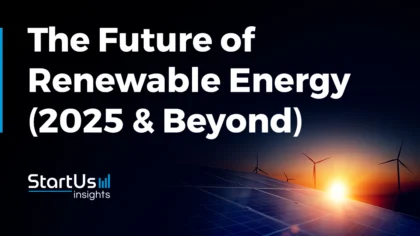
![Dive into the Top 10 Energy Industry Trends and Innovations [2025]](https://www.startus-insights.com/wp-content/uploads/2025/03/Energy-Trend-SharedImg-StartUs-Insights-noresize-420x236.webp)
